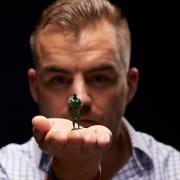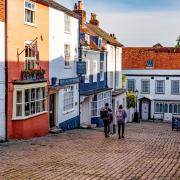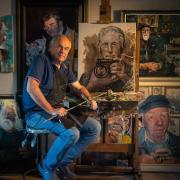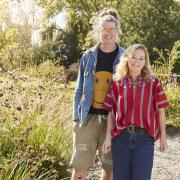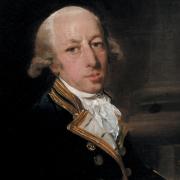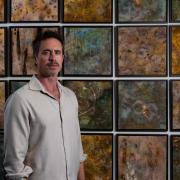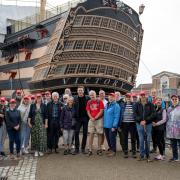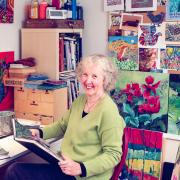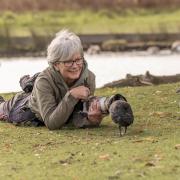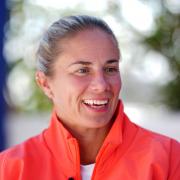An excellent exhibition has launched this month in the heart of Hampshire at Petersfield Museum and Art Gallery. ‘Peggy Guggenheim: Petersfield to Palazzo’ curated by Louise Weller, explores the remarkable life of American socialite and famous art collector Marguerite ‘Peggy’ Guggenheim (1898-1979) who lived near Petersfield in 1934. Ninety years ago she bought Yew Tree Cottage at Hurst Green, a pretty four-bedroom Elizabethan property with an acre of land. She sold the cottage in 1939 at the onset of the Second World War, but it was while living here that Peggy formulated the idea of opening an art gallery. She succeeded, at first in London with Guggenheim Jeune in 1938, later opening Art of this Century in her home city of New York, and finally in Palazzo Venier dei Leoni, situated on the Grand Canal in Venice. In 1949 the palazzo became a permanent home for Guggenheim and her remarkable collection of contemporary art, which she opened to the public in 1951. The exhibition includes loans from the Peggy Guggenheim Collection, Venice – whose Director, Karole P. B. Vail, is Peggy Guggenheim’s elder granddaughter.

The name Guggenheim is synonymous with wealth. Peggy’s uncle Solomon R. Guggenheim created his fortune from the mining industry in the USA and South America. In New York his foundation opened the Museum of Non-Objective Painting in 1939, known today as The Guggenheim, affiliated with Guggenheim museums worldwide. Peggy Guggenheim’s branch of the family were the relatively less-wealthy relations. In her early teens her father Benjamin Guggenheim had drowned on the maiden voyage of the SS Titanic. At home, her scholastic education was provided by tutors and included travel in Europe with her two sisters. At the age of 21Peggy inherited her own wealth, primarily through the banking family of her mother Floretta Seligman. However, in defiance of the conventions and traditions of her upbringing, in 1920 she was a clerk at the modern bookshop in New York, The Sunwise Turn. Here, she encountered avant-garde writers and artists, including Laurence Vail whom she married and had two children, Sindbad and Pegeen.

Yew Tree Cottage was not Peggy Guggenheim’s first home in England. In the summer months of 1932 and 1933, divorced from Laurence, she had rented Hayford Hall near Dartmoor Forest in Devon, and then Warblington Castle near Langstone in 1934, which she shared with her lover, the English writer Douglas Garman.. From here, she was known to have regularly driven the family to Hayling Island, to swim in the sea.

The choice of Petersfield came about through visits to Douglas' mother’s house, Vine Cottage in South Harting near Petersfield. She purchased Yew Tree Cottage and put it in Douglas' name, explaining in her autobiography Peggy Guggenheim: The Life of an Art Addict, that she chose the cottage because it was on the bus route between Harting and Petersfield. She settled her daughter Pegeen in to the local Winton House Preparatory School on Petersfield High Street, which she attended alongside Garman’s daughter Debbie and his niece Kitty; the three girls becoming good friends. Yew Tree Cottage became an idyllic family home for Peggy and Douglas and Debbie and Pegeen. Douglas created a beautiful garden, adding a small swimming pool for the children. Far from her glamorous life as an heiress and art collector, Guggenheim noted in her autobiography that everyday life in Yew Tree Cottage involved such day-to-day things as draughty rooms, water pumps, cooking and trips into Petersfield. A selection of paintings by Flora Twort of Petersfield and Langstone will complement the exhibition and give a sense of the places and scenes that would have been familiar to Peggy at this time. During this period, Yew Tree Cottage was host to Yves Tanguy, who carved a ring for Peggy from rosewood grown in the garden, which will also be on display.

Cricket-mad Sinbad had been living with his father in Austria before returning to England to board at nearby Bedales School between 1936-39. Peggy would collect him each Sunday for the day and Hampshire press records show the Garman-Guggenheim family played an active part in local life. Douglas made speeches at Petersfield Labour Party meetings while the children were mentioned in newspaper reports of dance shows, recitals and plays.
In her autobiography the chapter ‘Yew Tree Cottage’ captures her domesticated life at home and the moment she decided to move on from an uncertain life in Petersfield. The relationship between Peggy and Douglas had deteriorated, due to his increasing involvement with the Communist Party. Their daughters’ friendship and attendance of Winton House followed by a boarding school in Wimbledon, kept them together for a while but eventually Douglas only visited at weekends, living in London during the week. Peggy needed to liberate herself from the unfulfilling existence she shared with him. Her children both away at school must have left time to contemplate what she might do. Not just to amuse herself but to make a career-move, possibly in publishing or in art. Peggy asked her friend and art historian Herbert Read to help her establish a modern art museum in London, writing: 'We are going to have publications and lectures and be a general living art centre and of course give exhibitions of art.' And in January 1938, Guggenheim Jeune at 30 Cork Street, London opened, aided by the French artist Marcel Duchamp. He was a good friend who mentored Peggy on contemporary art, advising her what to buy, and who to invest in. The first exhibition, curated by him, focused on drawings by the French artist-writer Jean Cocteau. Peggy said that initially she had not been able to recognize differences in modern art movements but Duchamp had taught her. She made a vow to herself to buy an artwork each day, it was her motto, thus creating an extensive collection of works by avant-garde artists. At home, Peggy’s domestic life still centred around Petersfield until 1939 when war in Europe erupted. She sold Yew Tree Cottage and left England for Paris and then on to New York.

Now living in New York, Peggy Guggenheim opened a new gallery Art of this Century in 1942 and gave American artist Jackson Pollock his first show in 1943. This was a separate venture to her uncle’s art gallery, from which she received no funds or encouragement. In her personal life, a second marriage from 1941-46 to the Surrealist artist Max Ernst had ended. Peggy closed the gallery in 1947 and moved back to Europe, choosing Venice. It was while staying in Venice, looking for a residential property to purchase, that she loaned her art collection to the curators of the 1948 Venice Biennale. It created a sensation. For many visitors this was the first time that American contemporary artists’ work, including Jackson Pollock and the Abstract Expressionists had been exhibited in Europe.

In Venice, Peggy purchased Palazzo Venier dei Leoni, an unfinished, mid-18th century one-storey property on the Grand Canal. It was to become her home for thirty years until her death in 1979 aged 81 years. The Peggy Guggenheim Collection remains open to the public today, a connection to the exhibition Peggy Guggenheim: Petersfield to Palazzo, which brings together her family life and the many artists, literary friends and associates that knew her, while mapping her life from Petersfield, Hampshire to Venice, Italy. Commenting on the exhibition, Peggy's granddaughter, Karen P.B Vail says: 'It will be wonderful to have an exhibition exploring an unexpected and wonderful little-known chapter in Peggy Guggenheim’s eventful life before she began her life as a committed patron of the arts.'
PAY A VISIT
‘Peggy Guggenheim: Petersfield to Palazzo’ opens on June 15 until October 5 2024.
Petersfield Museum and Art Gallery
St Peter’s Road, Petersfield GU32 3HX
petersfieldmuseum.co.uk




